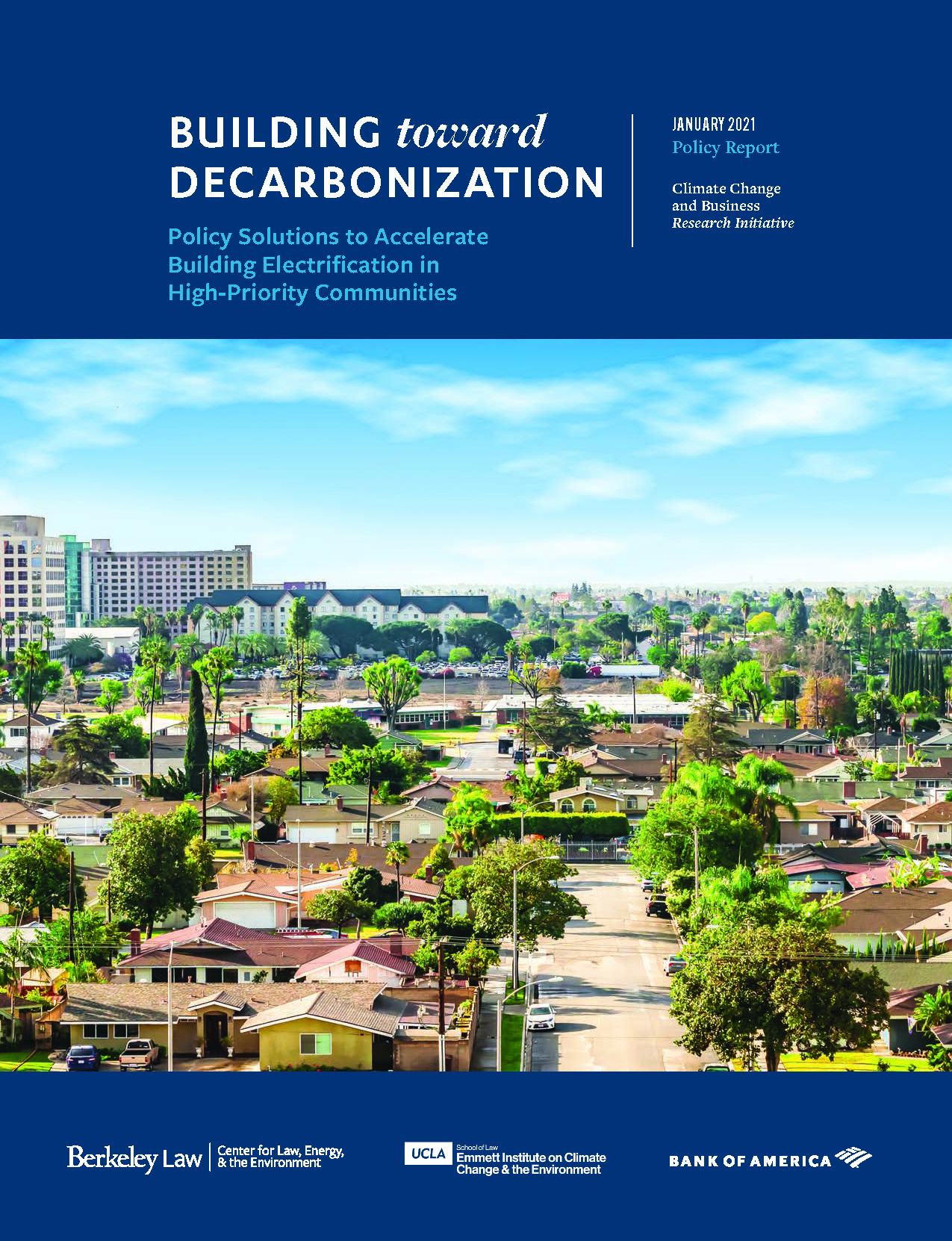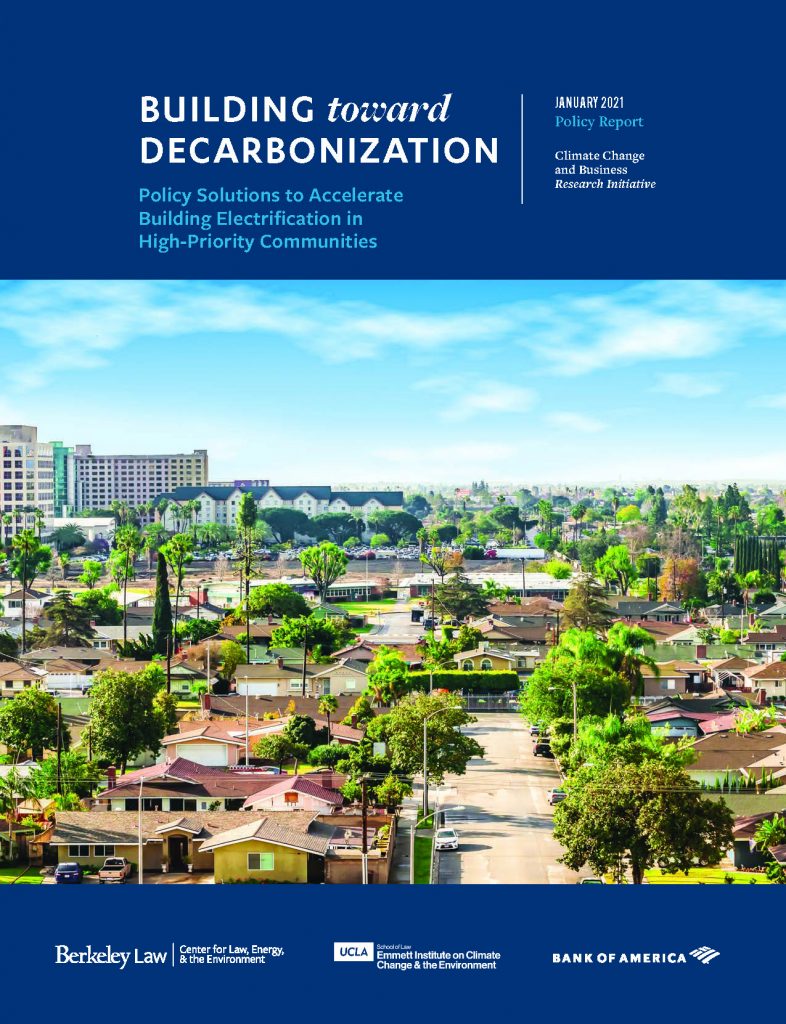All-electric buildings may soon become the norm, bringing benefits for indoor air quality, public safety, and greenhouse gas emissions. The technology has greatly improved to make this transition feasible: electric heat pumps, electric water heaters and induction cooktop appliances are widely available and becoming increasingly affordable.
But as communities phase out natural gas in buildings, who will be left paying for the existing natural gas infrastructure? For those unable to make the transition, costs will go up. As a result, states like California have an urgent need to develop a strategy for building decarbonization, as our January Berkeley/UCLA Law report on this subject described.
In a new op-ed published yesterday by CalMatters, Ted Lamm and I argue for such a strategy:
Policymakers should begin with high-priority communities, targeting incentives and programs for lower-income communities with the least financial resources and the most to gain from improved air quality; areas with new construction and/or aging gas infrastructure already in need of replacement; communities with an expressed willingness to transition; and areas rebuilding from wildfire damage.
This strategy should include a firm timeline for the transition to complete electrification, in order to limit the risk of developing stranded assets in the natural gas distribution network. Otherwise, these assets could increase costs for a shrinking group of customers who can’t afford to make the switch quickly and could undermine the long-term viability of utility investments and system maintenance.
State leaders should also develop a structured plan for a just transition for gas system workers, including funding and retraining support in fields that pay sustainable wages.
And for more discussion on the topic, here is a recording of a webinar that Berkeley / UCLA Law hosted last month with Michael Colvin of Environmental Defense Fund, California Public Utilities Commissioner Cliff Rechtschaffen, and Abigail Solis of Self Help Enterprises.
Today, the Center for Law, Energy and the Environment (CLEE) at Berkeley Law and the Emmett Institute on Climate Change and the Environment at UCLA Law are releasing a new report, Building toward Decarbonization, which highlights the key barriers and policy solutions to accelerate building electrification retrofits and new construction in California’s high-priority communities.

Commercial and residential building consumption of natural gas—to power heating and cooling, water heating, and cooking equipment—is currently responsible for about 10 percent of California’s greenhouse gas emissions, as well as harmful indoor air pollution. Transitioning the state’s buildings from natural gas to all-electric—such as electric heat pumps, electric water heaters, and induction cooktops—is thus one of the top priorities for statewide decarbonization and carbon neutrality by 2045. Over 40 cities have already taken municipal action to phase out building natural gas use, including all-electric new construction ordinances in Oakland, San Francisco, and San Jose.
But the transition presents significant regulatory, economic, and infrastructure challenges.
Developing a statewide strategy and timeline for the transition will be essential to achieve state decarbonization goals, and as the new report describes, this strategy will be most effective if it is targeted first toward communities and building types that will benefit most from state support and incentives. These include:
- Lower-income and disadvantaged communities with the least financial resources and the most to gain from improved air quality;
- Communities currently investing in new building construction;
- Communities with aging gas infrastructure already in need of replacement;
- Communities with an expressed willingness to transition; and
- Communities rebuilding from recent wildfires.
In a state that chronically under-builds new housing and will still have millions of pre-1990 homes in place in 2050, the retrofit challenge is especially urgent. And retrofitting existing buildings in lower-income communities—which tend to have more renters, more multifamily buildings, older construction, and less available capital—is a particularly thorny challenge: replacing gas HVAC, water, and cooking systems with all-electric alternatives can save money in the long run, but upfront installation costs are high, and landlords may have limited incentives to upgrade appliances when they aren’t responsible for utility bills. In addition, existing utility business and regulatory frameworks can limit incentives to accelerate the transition (or in some cases may bar the removal of gas service), compounding the after-effects of a long history of service denial in some communities.
All of these challenges overlay the systemic risk of developing stranded assets in the natural gas distribution network if the transition is insufficiently structured, which could threaten the financial viability of utilities, physical safety of the system, and costs for customers who can’t afford to make the switch independently.
Fortunately, state leaders have an opportunity to address these challenges by developing a reasoned plan to manage the electrification transition in order to meet state climate goals and address the needs of stakeholders including high-priority communities and natural gas system workers. Building Toward Decarbonization recommends these priority solutions:
- Setting a clear timeline (via executive order or legislation) for the long-term phase-out of natural gas to provide certainty for utilities and investors and mitigate stranded asset impacts on customers.
- Clarifying electric and utilities’ legal “obligation to serve” to ensure that electrical service can be substituted for gas service so long as energy access is maintained.
- Crafting a structured plan for a just transition for gas system workers including funding, retraining support, and targeted early retirement opportunities.
- Communicating the air quality benefits and performance qualities of electric stoves, hot water heaters, and other equipment to build public support for the transition.
Ultimately, California’s achievement of carbon neutrality by 2045 will hinge on this transition, particularly as the state continues to advance its goal of system-wide resilience through load management and flexibility.
You can read the full report here.
To learn more about potential solutions to accelerate the building electrification transition, register for our free webinar on Tuesday, February 23 at 1pm. Speakers include:
- Michael Colvin of Environmental Defense Fund
- California Public Utilities Commissioner Cliff Rechtschaffen
- Abigail Solis of Self Help Enterprises
They will join us to discuss priorities and opportunities for the coming decade of the decarbonization effort. Register here.
This post is co-authored with Ted Lamm and cross-posted on Legal Planet.

Climate advocates are pushing for “building electrification” to get new and existing building off of natural gas altogether through appliance-switching, which would provide significant greenhouse gas savings and indoor air quality benefits (as I discussed last week). Now we have a new study documenting some significant cost savings (as well as emission reductions) that this switch could provide to homeowners who get off natural gas.
Energy and Environmental Economics, Inc. (E3) released the study quantifying the economic impacts of this transition for consumers of various appliances in existing and new residential buildings. Funded by utilities including Southern California Edison, Sacramento Municipal Utility District, and the Los Angeles Department of Water and Power, the researchers analyzed the cost impacts of electric air source heat pumps for space heating and cooling (HVAC), heat pump water heaters, electric and induction stoves, as well as electric and heat pump clothes dryers, compared individually to their natural gas alternatives.
The economic savings were notable. For new residential construction, all-electric appliances with today’s technology would result in lifecycle savings of $130 -$540 per year. It’s less clear though what the savings might be in general for retrofitting existing homes, as it depends on whether the building requires an electrical upgrade for all these new appliances and whether the homes have air conditioning.
The study also evaluated specific technologies in depth, including the key technology of electric heat pumps instead of using gas furnaces to heat homes. These heat pumps work by extracting heat from even cold winter air outside and pumping it indoors, and then pumping hot summer indoor air outside to cool a building.
E3 found the following cost-savings benefits with these heat pumps:
The installation of HVAC heat pumps can result in up to $550 per year in lifecycle savings relative to a combined gas furnace plus air conditioner(AC)system… However, homes without AC incur an extra lifecycle cost of $200 per year by switching to an HVAC heat pump. Heat pump water heaters (HPWHs) generate lifecycle savings of up to $150 per year over gas tankless water heaters in almost all home applications, but in retrofit homes, gas storage water heaters still appear to be the cheapest option… The net lifecycle costs of HPWHs are driven mainly by the capital cost.
Meanwhile, they found that electric hot water heaters generate savings of $150 per year over tankless natural gas heaters in new homes (not retrofits), as do electric cooktops. Electric clothes dryers though are currently more expensive than gas options.
In terms of emissions, the study found greenhouse gas reductions in single-family homes of 30%–60% over a natural-gas fueled home, given the projected electricity mix in 2020, and 80%–90% by 2050, assuming the projected carbon intensity of the grid by that year is realized.
Overall, the study is good news for those pushing for building electrification, as well as for any homeowner interested in making the switch to electric appliances to save money and reduce negative health impacts. With smart policy incentives to encourage adoption of these technologies in the home, from improved building standards to expanded financial incentives, California’s leaders could help homeowners achieve even further savings.



